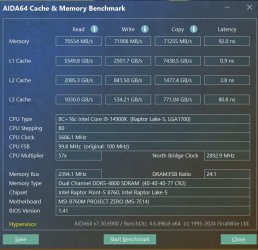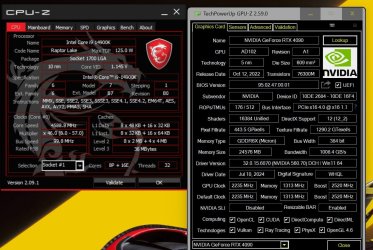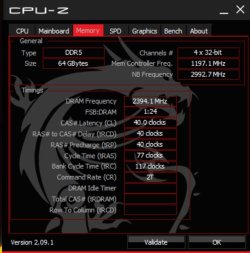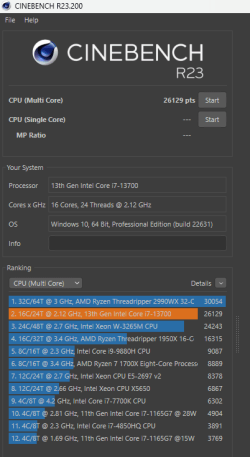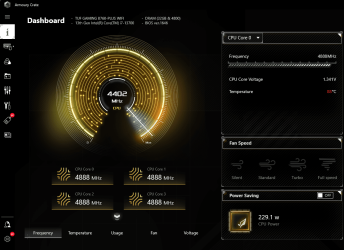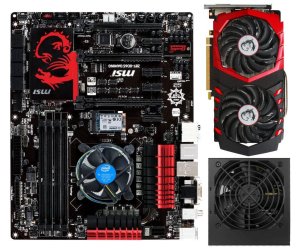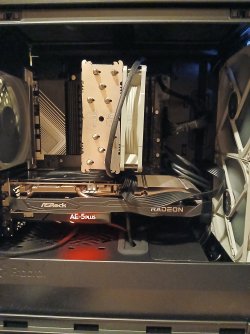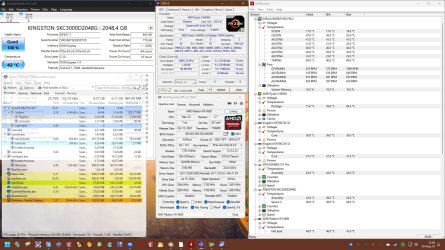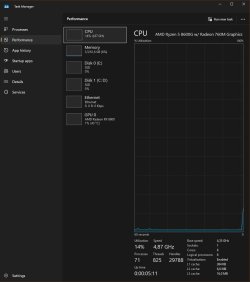- Local time
- 6:57 PM
- Posts
- 2,341
- OS
- WIN 11, WIN 10, WIN 8.1, WIN 7 U, WIN 7 PRO, WIN 7 HOME (32 Bit), LINUX MINT
Well, at least we agree on this much. And any over clocking enthusiast would agree that every bit counts. I'm not assuming that our friend is an over clocking enthusiast but I'm not assuming otherwise either. Either way, a little extra in the way of cooling — especially exhaust — can't hurt but it certainly can help.Could is key, and "significantly" is also a key term here. What is a significant improvement? How can one prove a significant improvement?
Even with economics there is a law of diminishing returns. That said a couple of extra fans aren't going to break the budget (I hope). Being more of a hardware guy I tend not to lean too heavily on what the software is telling me and I know for a fact 'stuff' will happen. A little extra insurance canIn theory, yes every bit helps. But where do you draw a line? If you drop it by 10 degrees and it helps, should you go above and beyond to also try to get to 12 degrees. What if you could add a bunch more fans and get even 13 degrees? But if it's within operating spec, what could this significant improvement be?
(and often does) go a long way. It is not unknown for builds within operating specs to fail as a result of bad thermals. I remember Wendell doing a video on this concerning ThreadRipper and showing pictures of the discoloured contacts on the bottom of the chip even though it was supposed to be "within operating specs". So I might well imagine that the significant improvement, if it were to be measured, would carry a number of variables that people better equipped and trained to measure than you or I would be able to expound upon.
This is true. Some people could read that and think they might only get two years out of their CPU and if they were, for example, overclocking it without adequate cooling they might well be correct. Again, I was assuming nothing here. Another good motto is to plan for the best and prepare for the worst. I've had the PC I'm typing on here for well over 12 years and I'm not about to abandon it any time soon. Someone who spends a "significant" amount of coin on a PC generally wants it keep it running ship shape for an extended period of time. In this regard putting a couple of extra fans in the appropriate places might be a worth while consideration.I think some people could read that and think, man if I don't take action i "might" only get 2 years out of my CPU. But if I just add more cooling, I could get 6, 8, 12 or even 22 years out of that same CPU. That would be significant. But I would bet dollars to donuts, if we are talking about a cpu running within range, that chances are HIGHLY LIKELY that the lifepan of the CPU without additional cooling is likely to be longer than you plan to keep it or actually use it anyway.
I'm not saying everyone else is wrong either. I merely made a suggestion that having a rear exhaust fan would be a good idea. I know that a push/pull configuration on Noctua heat sinks does make a significant difference from first hand experience. With respect to air cooling I've found it to be one of the more affordable ways of reducing thermals, but I'm not commanding or demanding that anyone do anything.
My Computer
System One
-
- OS
- WIN 11, WIN 10, WIN 8.1, WIN 7 U, WIN 7 PRO, WIN 7 HOME (32 Bit), LINUX MINT
- Computer type
- PC/Desktop
- Manufacturer/Model
- DIY, ASUS, and DELL
- CPU
- Intel i7 6900K and i9-7960X / AMD 3800X (8 core)
- Motherboard
- ASUS X99E-WS USB 3.1 and ASUS X299 SAGE
- Memory
- 128 GB CORSAIR DOMINATOR PLATINUM (B DIE)
- Graphics Card(s)
- NVIDIA 1070 and RTX 3070
- Sound Card
- Crystal Sound (onboard)
- Monitor(s) Displays
- single Samsung 30" 4K and 8" aux monitor
- Screen Resolution
- 4K and something equally attrocious. I'll be working on this.
- Hard Drives
- A, B, C, D, E, F, G, H, I, J, K, L, M, N, O, P, Q, R, S, T, U, V, W
Ports X, Y, and Z are reserved for USB access and removable drives.
Drive types consist of the following: Various mechanical hard drives bearing the brand names, Seagate, Toshiba, and Western Digital. Various NVMe drives bearing the brand names Kingston, Intel, Silicon Power, Crucial, Western Digital, and Team Group. Various SATA SSDs bearing various different brand names.
RAID arrays included:
LSI RAID 10 (WD Velociraptors) 1115.72 GB
LSI RAID 10 (WD SSDS) 463.80 GB
INTEL RAID 0 (KINGSTON HYPER X) System 447.14 GB
INTEL RAID 1 TOSHIBA ENTERPRIZE class Data 2794.52 GB
INTEL RAID 1 SEAGATE HYBRID 931.51 GB
- PSU
- SEVERAL. I prefer my Corsair Platinum HX1000i but I also like EVGA power supplies
- Case
- ThermalTake Level 10 GT (among others)
- Cooling
- Noctua is my favorite and I use it in my main. I also own various other coolers.
- Keyboard
- all kinds.
- Mouse
- all kinds
- Internet Speed
- 360 mbps - 1 gbps (depending)
- Browser
- FIREFOX
- Antivirus
- KASPERSKY (no apologies)
- Other Info
- Gave Dell touch screen with Windows 11 to daughter and got me an OTVOC. Being a PC builder I own many desktop PCs as well. I am a father of five providing PCs, laptops, and tablets for all my family, most of which I have modified, rebuilt, or simply built from scratch. I do not own a cell phone, never have, never will.

